History of the University of Florida

The history of the University of Florida is firmly tied to the history of public education in the state of Florida. The University of Florida originated as several distinct institutions that were consolidated to create a single state-supported university by the Buckman Act of 1905. The earliest of these was the East Florida Seminary, one of two seminaries of higher learning established by the Florida Legislature.[1] The East Florida Seminary opened in 1853, becoming the first state-supported institution of higher learning in the state of Florida;[2] the University of Florida traces its founding date to that year.
The East Florida Seminary operated in Ocala until the outbreak of the American Civil War in 1861. It closed for the duration of the war, and reopened in Gainesville in 1866, absorbing the Gainesville Academy. The other primary predecessor to the University of Florida was the Florida Agricultural College, established at Lake City in 1884 by Jordan Probst. Florida Agricultural College became the first land-grant college in the state, and the small college emphasized the scientific training of agricultural and mechanical specialists. In 1903, the Florida Legislature changed the name of Florida Agricultural College to the "University of Florida", in recognition of the legislature's desire to expand the curriculum beyond the college's original agricultural and engineering educational missions.
In 1905 the Buckman Act restructured higher education in Florida, and the state's six standing institutions were reorganized into three schools segregated by race and gender. The act mandated the merger of four of these institutions – the East Florida Seminary, the University of Florida at Lake City (formerly Florida Agricultural College), the St. Petersburg Normal and Industrial School in St. Petersburg, and the South Florida Military College in Bartow – into the University of the State of Florida, a university for white males.[3] The school began accepting some white women starting in 1924, and became fully coeducational as a result of the influx of new students brought in by the GI Bill after World War II. It became racially integrated in 1958. Into the 21st century the school grew substantially in size and increased in academic prominence, becoming a member of the Association of American Universities in 1985. It is now known as The University of Florida.
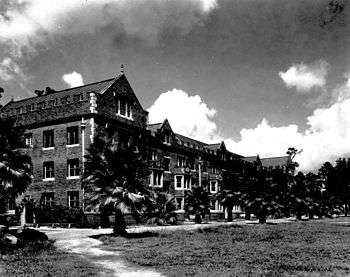
Origins
In 1823, the Florida Territorial Legislature and the United States Congress began to plan a system of higher education for Florida.[4] As early as 1836, Congress authorized the establishment of a "University of Florida," and the first constitution of Florida Territory in 1838 specifically guaranteed that seminaries of higher learning be created.[5][6] It was not until the 1850s, however, that the Florida Legislature took steps towards implementing these plans. In 1851, the legislature voted to allow the establishment of two seminaries on either side of the Suwannee River: West Florida Seminary (which was the predecessor of Florida State University) and East Florida Seminary. The latter became the first of the institutions that were eventually merged to create what is now known as the University of Florida.[5]
On January 6, 1853, Florida governor Thomas Brown signed the legislation that provided public support for the seminaries. Gilbert Kingsbury was the first person to seek state support under the legislation, and established the East Florida Seminary in Ocala, Florida. This was the first state-supported institution of higher learning in the state of Florida.[2] The seminary closed in 1861 due to the Civil War, and remained so for the duration of the war.[7] In 1866, James Henry Roper, an educator from North Carolina and a Florida State Senator from Alachua County, offered his Gainesville Academy and all associated property to the state in exchange for the seminary relocating there. Roper had founded the Academy in downtown Gainesville in 1858. The state accepted his offer, and parts of the seminary campus would be incorporated into the campus of the future University of Florida. Epworth Hall, the main building of the East Florida Seminary, still stands in downtown Gainesville, though it is not within the university's present campus boundaries.[8]
In 1884, Jordan Probst established what became the other major predecessor to the University of Florida, Florida Agricultural College, in Lake City. Florida Agricultural College became the first land-grant college in the state, and the small college emphasized the scientific training of agricultural and mechanical specialists. In 1903, the Florida Legislature changed the name of Florida Agricultural College to the "University of Florida," in recognition of the legislature's desire to expand the curriculum beyond the college's original agricultural and engineering educational missions.
University
Florida's 1868 constitution required the establishment of a state-sponsored university. The state's first attempts to establish a multi-college university were in Tallahassee, where the West Florida Seminary was located. In 1883, a charter passed which merged the West Florida Seminary and the Tallahassee College of Medicine and Surgery into the Florida University, the first such institution in the state.[9] The West Florida Seminary became the university's Literary College, containing several "schools" or departments; however its "separate Charter and special organization" were maintained.[10] The university charter also recognized three further colleges to be established at a later time: a Law College, a Theological Institute, and a Polytechnic and Normal Institute.[10]
The Florida Legislature recognized the institution in 1885 under the name "University of Florida", but it refused to supply any additional funding.[11] Without state financial support the university venture struggled, and the medical college relocated to Jacksonville later that year.[9] The Tallahassee institution never actually adopted the "university" title.[11] Florida Agricultural College attempted to revive the idea, announcing its desire to merge with the University of Florida in 1886 and 1887, however, nothing came of this at the time.[11] Then, in 1903, the legislature repealed the act designating the Tallahassee institution as the "University of Florida," and transferring the title to Florida Agricultural College.[11] This institution operated as the University of Florida until 1905, when Florida's higher education system was entirely reorganized by the Buckman Act.[12]
University of the State of Florida
.jpg)
In 1905 the state passed the Buckman Act, which reorganized the State University System of Florida and empowered the Florida Board of Control to govern the system. The act, named for legislator Henry Holland Buckman, mandated the consolidation of the state's six institutions into three: one for African Americans, one for white women, and one for white men. Four of the institutions – the University of Florida at Lake City (formerly Florida Agricultural College) in Lake City, the East Florida Seminary in Gainesville, the St. Petersburg Normal and Industrial School in St. Petersburg, and the South Florida Military College in Bartow – were merged into the new University of the State of Florida.
The University of the State of Florida served as the institution for white men; the State Normal School for Colored Students (the future Florida A&M University) served African Americans, and the Florida Female College (the future Florida State University) served white women.[13] A fourth school provided specialized training and education for the deaf and blind (the Florida School for the Deaf and Blind).
On July 6, 1905, the Board of Control, by a 6–4 vote, selected Gainesville for the campus of the state's newly consolidated men's university. The Board of Control selected Andrew Sledd, president of the University of Florida at Lake City for the last year, to be the first president of the new university, and architect William A. Edwards to design the first permanent buildings for the new Gainesville campus in the Collegiate Gothic style. The 1905–1906 academic year was a time of transition; classes were held on the existing Lake City campus of the former University of Florida at Lake City, while the first buildings of the new Gainesville campus were being constructed. The new university held its first classes on its Gainesville campus on September 26, 1906, with 102 students enrolled.
The name of the fledgling university was simplified to the "University of Florida" in 1909. The alligator was incidentally chosen as the school mascot in 1911, after a local vendor ordered and sold school pennants with a gator emblem on them. The university colors, orange and blue, are believed to be a combination of the blue and white school colors of the University of Florida at Lake City and the orange and black school colors of the East Florida Seminary in Gainesville, the university's two primary predecessors.[14]
Reorganization, reform, depression and war
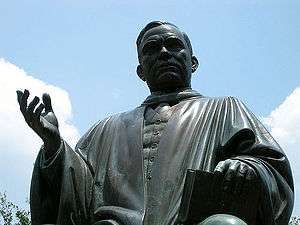
Albert A. Murphree was appointed the second president of the University of Florida in 1909. Murphree previously served as the president of the Florida State College for Women (later known as "Florida State University"). Murphree was responsible for the internal re-organization of the university and the creation of its first constituent colleges and schools. During his presidency, the university's student enrollment increased from just under 200 to over 2,000.
In 1924, the Florida Legislature permitted women of a "mature age" (at least 21 years old) who had completed sixty semester hours from a "reputable educational institution" would be allowed to enroll during regular semesters at the university in programs that were unavailable at Florida State College for Women. Before this, only the summer semester was coeducational, to accommodate teachers.[15] Lassie Goodbread-Black from Lake City became the first woman to enroll at the University of Florida, at the College of Agriculture in 1925.[16]
John J. Tigert became the university's third president in 1928. Before arriving in Gainesville, Tigert had been the president of Kentucky Wesleyan College; a philosophy professor, athletic director, basketball coach and football coach at the University of Kentucky; and the U.S. Commissioner of Education for seven years. Tigert brought many new ideas for reforming academics, athletics and administration to the university. Disgusted by the under-the-table payments being made by universities to athletes in this era, Tigert advocated the grant-in-aid athletic scholarship program in the early 1930s, which was the genesis of the modern athletic scholarship plan currently used by the NCAA.[17] Under Tigert's administration, the university built its football stadium, joined the new Southeastern Conference for its sports teams, awarded its first doctoral degrees, was granted a chapter of Phi Beta Kappa, established the new University College and placed new emphasis on liberal arts general education requirements.
When the United States entered World War II following the Japanese attack on Pearl Harbor on December 7, 1941, most students withdrew to enlist in the U.S military. Having survived the financial stresses and strains of the Great Depression, the university could have failed financially when most of its student body departed. To survive the financial stresses of the war years, the university offered its campus, classrooms and dormitories to the U.S. Government for the training of aircrews for the U.S. Army Air Force.
GI Bill and post-World War II era
When World War II ended and veteran students began to return to Gainesville in 1946, the university was overwhelmed with both returning and new students buoyed by their GI Bill of Rights (Servicemen's Readjustment Act) educational benefits. By 1947, over 7,500 students were enrolled, more than three times the number of students in 1928.
Unable to accommodate the immediate increased demand for college education in Florida, the Florida Board of Control opened the Tallahassee Branch of the University of Florida on the campus of Florida State College for Women in Tallahassee.[18] By the end of the 1946–1947 school year, 954 men were enrolled at the Tallahassee Branch. The following semester, the Florida Legislature returned the Florida State College for Women to coeducational status and renamed it Florida State University. Thereafter, all of the university's various colleges and schools were open to female students. The J. Hillis Miller Health Science Center was founded in 1956 and Shands at the University of Florida was founded two years later, at the same time as the College of Medicine was established under the direction of dean George Harrell. Rapid expansion of the university's campus structures and student population began in the 1950s under presidents J. Hillis Miller, Sr. and J. Wayne Reitz. Under Reitz, the university peacefully integrated and African-American students were allowed to enroll in the university in 1958.
National and international prominence
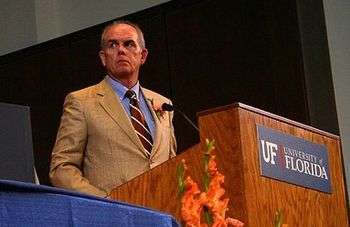
In 1985, Florida became a member of the Association of American Universities (AAU), a higher-education organization presently composed of sixty-two public and private United States and Canadian research universities. Florida is one of thirty-four public universities that belong to the AAU. In 2009, President Bernie Machen and the University of Florida Board of Trustees announced the future reduction of the number of undergraduates, and an increase of resources for graduate education and research.[19]
The University of Florida has continued to rise in the U.S. News & World Report college and university rankings. In 2001, Florida was labeled a Public Ivy, and, in 2010, was ranked second in Kiplinger's "Best Buys of Education," behind the University of North Carolina).[20] U.S. News & World Report currently ranks the University of Florida among the top forty-seven national universities, public and private, and fifteenth among all public national universities.[21]
In 2013, Florida Governor Rick Scott publicly announced his support for the University of Florida to ascend into the top ten among public universities, as measured by U.S. News & World Report.
Historic sites
A number of the University of Florida's buildings are historically significant. The Campus Historic District comprises numerous buildings and encompasses approximately 650 acres (2.6 km2).[22] Two buildings outside the historic district, the old WRUF radio station (now the university police station) and Norman Hall, are also listed on the historic register.[23] The buildings listed on the U.S. National Register of Historic Places for their architectural or historic significance are:
Timeline of colleges
| University presidents | |
|---|---|
| President | Years |
|
| |
| Andrew Sledd | 1905 – 1909 |
| Albert A. Murphree | 1909 – 1927 |
| * James M. Farr | 1927 – 1928 |
| John J. Tigert | 1928 – 1947 |
| * Harold Hume | 1947 – 1948 |
| J. Hillis Miller, Sr. | 1948 – 1953 |
| * John S. Allen | 1953 – 1955 |
| J. Wayne Reitz | 1955 – 1967 |
| Stephen C. O'Connell | 1967 – 1973 |
| * E. T. York | 1973 – 1974 |
| Robert Q. Marston | 1974 – 1984 |
| Marshall Criser | 1984 – 1989 |
| * Robert A. Bryan | 1989 – 1990 |
| John V. Lombardi | 1990 – 1999 |
| Charles E. Young | 1999 – 2003 |
| J. Bernard Machen | 2003 – 2014 |
| W. Kent Fuchs | 2015 – Present |
| *Denotes acting/interim president See also List of University of Florida presidents | |
| College/school founding[24] | |||
|---|---|---|---|
| College/school | Year founded | ||
|
| |||
| College of Agricultural and Life Sciences | 1906 | ||
| Rinker School of Building Construction | 1906 | ||
| College of Education | 1906 | ||
| College of Law | 1909 | ||
| College of Engineering | 1910 | ||
| College of Liberal Arts and Sciences | 1910 | ||
| College of Journalism and Communications | 1916 | ||
| College of Pharmacy | 1923 | ||
| College of Design Construction and Planning | 1925 | ||
| Warrington College of Business | 1926 | ||
| P.K. Yonge Research School | 1934 | ||
| College of Health and Human Performance | 1946 | ||
| J. Hillis Miller Health Science Center | 1956 | ||
| College of Medicine | 1956 | ||
| College of Nursing | 1956 | ||
| College of Public Health and Health Professions | 1958 | ||
| Institute of Food and Agricultural Sciences | 1964 | ||
| College of Dentistry | 1972 | ||
| College of Fine Arts | 1975 | ||
| College of Veterinary Medicine | 1976 | ||
| Division of Continuing Education | 1976 | ||
| Fisher School of Accounting | 1977 | ||
| International Center | 1991 | ||
| Graham Center for Public Service | 2006 | ||
Historical photos
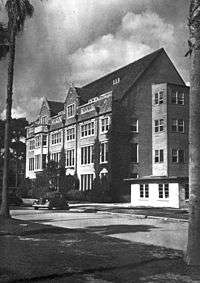
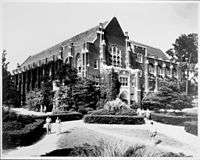



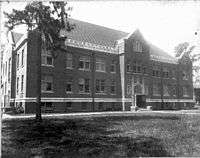
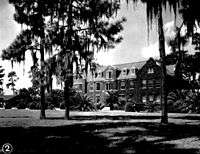
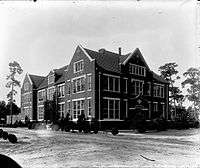 Benton Hall
Benton Hall
See also
- History of Florida
- History of Florida State University
- List of University of Florida alumni
- List of University of Florida buildings
- List of University of Florida faculty and administrators
- List of University of Florida presidents
- University of Florida Alumni Association
- University of Florida Athletic Association
- University of Florida Campus Historic District
Notes
- ↑ Klein, Barry (July 29, 2000). "FSU's age change: history or one-upmanship?". St. Petersburg Times. Retrieved July 13, 2010.
- 1 2 "Kingsbury Papers", Smathers Library.
- ↑ About the Buckman Act consolidation Archived 2006-08-26 at the Wayback Machine.
- ↑ Bush, p. 30.
- 1 2 Klein, Barry (July 29, 2000). "FSU's age change: history or one-upmanship?". St. Petersburg Times. Retrieved July 9, 2010.
- ↑ State Library and Archives of Florida - The Florida Memory Project, Florida Constitution of 1838, Article X - Education Archived 2007-06-24 at the Wayback Machine.. "Section 1. The proceeds of all lands that have been or may hereafter be granted by the United States for the use of Schools, and a Seminary or Seminaries, of learning, shall be and remain a perpetual fund, the interest of which, together with all monies derived from any other source applicable to the same object, shall be inviolably appropriated to the use of Schools and Seminaries of learning respectively, and to no other purpose. Section 2. The General Assembly shall take such measures as may be necessary to preserve from waste or damage all land so granted and appropriated to the purposes of Education." Retrieved on July 13, 2010.
- ↑ "UF Early History" Archived 2007-01-22 at the Wayback Machine., University of Florida.
- ↑ "The Heritage Collection.", Alachua Library.
- 1 2 Bush, pp. 46–47.
- 1 2 Constitutional Convention, Florida (June 9, 1885). Journal of the Proceedings of the Constitutional Convention of the State of Florida, p. 21. Harvard College Library. Retrieved July 13, 2010.
- 1 2 3 4 Armstrong, p. 40.
- ↑ Armstrong, p. 41.
- ↑ "State Library and Archives of Florida - The Florida Memory Project Timeline (see 1905)". Archived from the original on 2008-06-11. Retrieved 2008-06-05.
- ↑ University of Florida, University of Florida History 1906-1927 Archived 2008-12-27 at the Wayback Machine.. Retrieved July 13, 2009. The purported origins of the school colors and mascot are of uncertain accuracy.
- ↑ University of Florida: College of Liberal Arts and Sciences-Notable Women at UF
- ↑ University of Florida website: History-1925 » First Woman Enrolls Archived 2008-12-27 at the Wayback Machine..
- ↑ Fred Russell, "Columnary Craft: Pioneer of Open Aid," NCAA News, December 15, 1970. p. 2. Retrieved August 11, 2009.
- ↑ Florida State University, Florida State History. Retrieved August 15, 2009.
- ↑ UF looking to transform itself
- ↑ 2009 Kiplinger Ranking
- ↑ "Public Universities Chase Excellence, at Price." New York Times.
- ↑ "Florida's History Through Its Places: Alachua County". Florida Department of State. Retrieved 2008-09-09.
- ↑ Official UF Historic Site Guide.
- ↑ "University of Florida Colleges". University of Florida. December 26, 2008. Retrieved 2008-12-26.
References
- Armstrong, Orland Kay (c. 1928). "The life and work of Dr. A. A. Murphree, p. 40". Retrieved July 13, 2010.
- Bush, George G. (1898). History of Education in Florida. Washington, D.C.: U.S. Bureau of Education, Circular of Information 1888, # 7.
External links
| Wikisource has the text of the 1905 New International Encyclopedia article Florida Agricultural College. |

